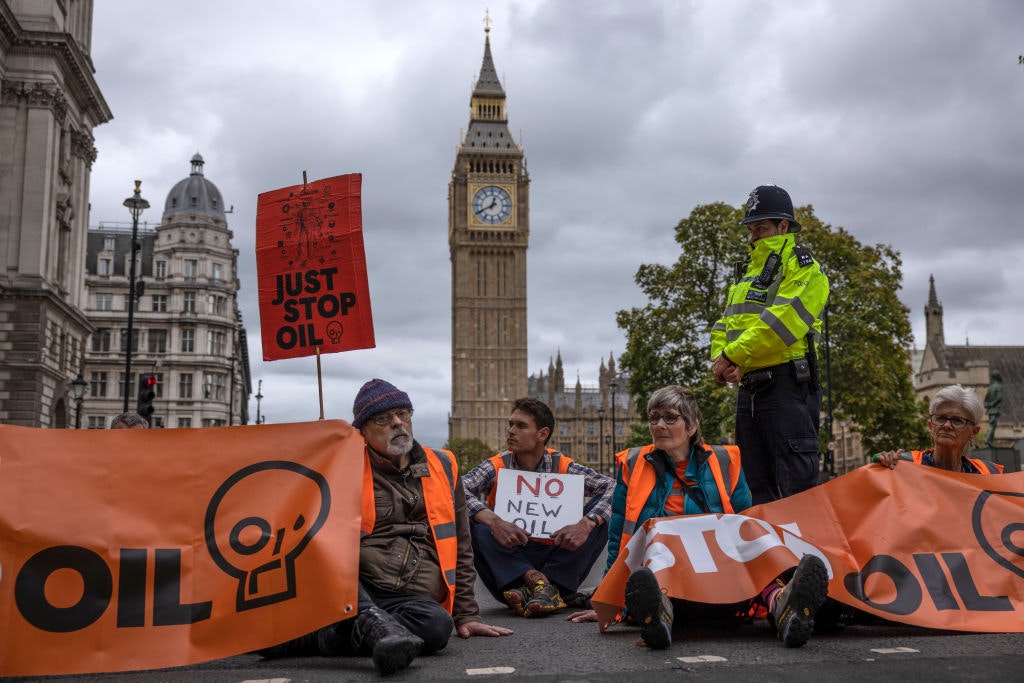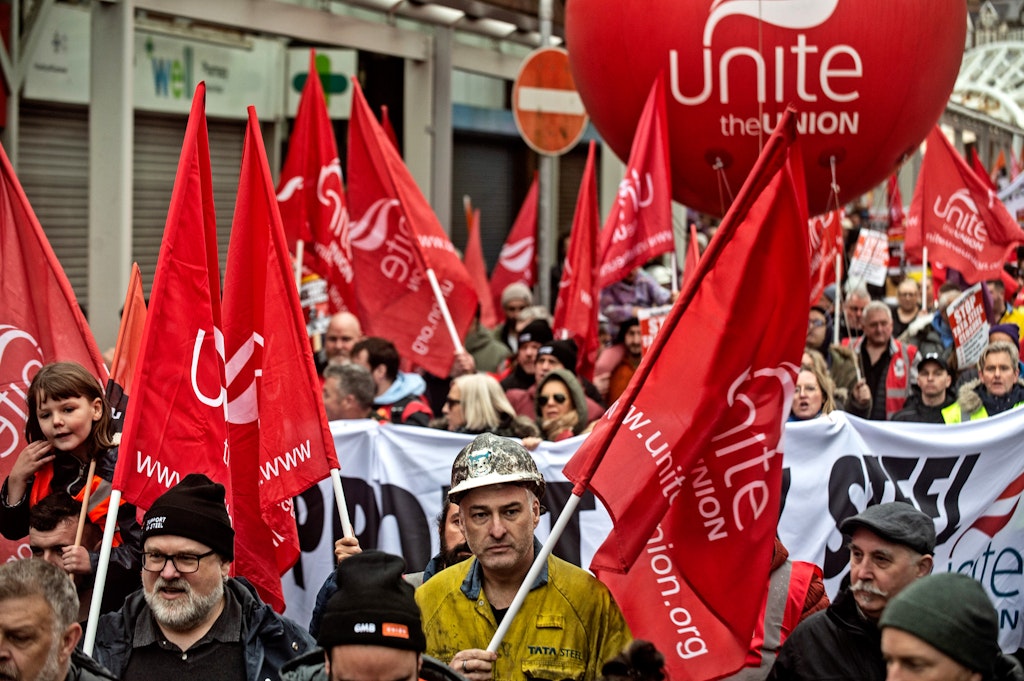The right to protest is not the right to crime
People who break the law have always faced consequences
Just Stop Oil has continued its disruptive protest over the last few weeks, promising to escalate its action as long as the government grants licences for fossil fuel exploration. On 14 October, two protesters hurled soup at Van Gogh’s painting The Sunflowers in the National Gallery and glued their hands to the wall. Thankfully, the painting was protected by Perspex, but the frame itself was reportedly damaged. Elsewhere, protesters have been obstructing roads across the capital, graffitiing the Scotland Yard sign and the shopfront of an Aston Martin dealership, climbing onto the Dartford Crossing bridge, stopping traffic and covering the front of Harrods with paint. Other groups protested too, with Animal Extinction pouring milk on supermarket floors and End Private Jets pouring urine and faeces on a memorial to Sir Captain Tom Moore.
The protester takes the punishment as evidence of his sincerity
Since the actions of Extinction Rebellion in 2019, many have trotted out arguments in favour of this disruptive protest. First they have decried efforts to punish it under the current law, with protesters often pleading not guilty and objecting to convictions. Then they have criticised government proposals to put in place further legislation where the current law has been insufficient in dealing with protesters’ interference with the rights of others. In respect of the first argument, the common line taken is that protest movements of the past have achieved positive social change when breaking the law and, in light of that, protesters should be protected from prosecution and conviction by rights to freedom of expression and assembly under the European Convention on Human Rights (the Convention). Enforcing the criminal law, they say, deprives citizens of the means of making effective protest.
This evinces a misunderstanding of the legal approach towards protest and the traditional arguments regarding civil disobedience and direct action. Lord Hoffmann expounded on this topic in R v Jones. In Jones, the appellants had either caused criminal damage at air bases and military ports or had attempted to do so. They argued that the invasion of Iraq by the UK and US had constituted the crime of aggression, and that they had been acting pursuant to section 3 of the Criminal Law Act 1967 so that they could rely on the defence of prevention of crime. The House of Lords found that aggression was not a domestic crime capable of being prevented under section 3. Following that determination, Lord Hoffman’s judgment went on to explore “the limits of self-help”, providing an overview of the way in which direct action could not be justified under the prevention of crime defence.
Lord Hoffmann started with the point that the State has a legitimate monopoly of violence and that, although there are circumstances where force may be used by citizens in preventing crimes when no other remedy may be found, the use of violence is entrusted to the police and the military. Lord Hoffmann then said that the law is even more circumscribed when a citizen is not protecting his own person or property. In cases where the State does not intervene, it is possible that it is because the State (the government of which is democratically elected) does not consider that a crime has been committed. If so, the citizen may lobby Parliament instead of taking the law into his own hands. To allow the use of force as direct action in such circumstances would create a dangerous precedent.
Lord Hoffmann then moved on to discuss civil disobedience. Civil disobedience had a “long and honourable” history in the UK, he said, and those who use such methods are “sometimes vindicated by history”. He then said a passage which merits being quoted in full:
It is the mark of a civilised community that it can accommodate protests and demonstrations of this kind. But there are conventions which are generally accepted by the law-breakers on one side and the law-enforcers on the other. The protesters behave with a sense of proportion and do not cause excessive damage or inconvenience. And they vouch the sincerity of their beliefs by accepting the penalties imposed by the law. The police and prosecutors, on the other hand, behave with restraint and the magistrates impose sentences which take the conscientious motives of the protesters into account. [Emphasis added.]
Lord Hoffmann was saying first, that self-help through the use of force was limited, especially when the State takes a different view of the “crime” being prevented; and second, that civil disobedience is an action where protesters deliberately break the law and accept the punishment. In so doing, they affect the conscience of the community, provided that their cause is a just and reasonable one. The same argument applies to forms of protest where force is not used which nonetheless engage the criminal law.
John Rawls likewise followed this line of argument regarding civil disobedience, saying that it “expresses disobedience to the law within the limits of fidelity to the law” and that “the law is broken, but fidelity to law is expressed by the public and nonviolent nature of the act, by the willingness to accept the legal consequences of one’s conduct”. The case may be different where the law being broken is itself unjust, such as in Penn and Meade, where a prosecution for Quakers preaching resulted in perverse acquittals (although, elsewhere, Martin Luther King did accept punishment in unjust law cases) but, where the process of law-breaking is designed to highlight a separate issue, the protester takes the punishment as evidence of his sincerity. Rawls contrasts this with militant action, where the militant rejects the sense of justice of democratic society and seeks to defy the legal order.
Protesters engaging in civil disobedience do not have the right to effective protest, nor do they have a right to continually break the criminal law. The protesters in these circumstances break the law in the hope of bringing attention to their cause. It may be the case that the majority rejects that cause, however, and elects governments which take a different view. It may also be the case that an elected government is better placed to weigh competing interests when making policy, and that the protesters are mistaken in their demands.
The Suffragettes deliberately broke the law and were convicted for it
Some commentators have blurred the distinction between civil disobedience and direct action on the one hand, and lawful protest on the other. Adam Wagner, from Doughty Street Chambers, said in a Select Committee hearing that “Protest has not changed; protest has always been a pain, a nuisance and liable to be inconvenient and tiresome” and that “Extinction Rebellion is no different from any widespread protest movement — the civil rights movement in the 1960s, the environmental movement previously”. The Guardian said that women gaining the franchise would not have happened but for the use of similar methods to Extinction Rebellion. Yet, protest of this type was dealt with through the criminal justice system, and police acted swiftly to deal with criminality. The Suffragettes deliberately broke the law and were convicted for it. The same goes for many environmentalists and civil rights protesters. Wagner’s attitude is to expand protest rights in respect of disruption, attempting to place acts of civil disobedience within lawful actions, thus going against civil disobedience’s philosophical justification.
The recent UK Supreme Court judgment in Ziegler contributes to some of this blurring. It mandated proportionality assessments under the Convention in cases of obstruction of the highway. Since the judgment, the police have been reluctant to make arrests and juries have on occasion acquitted protesters charged under s137 of the Highways Act 1980, presumably on proportionality grounds. In cases where protesters simply sit on major roads for extended periods of time, it is difficult to see how arrest and conviction could be disproportionate. Their obstruction strongly interferes with the rights of others. In any event, the judgment has caused confusion.
With regards to criticism of government proposals to pass legislation dealing with disruptive protest, Wagner objected to the Police, Crime, Sentencing and Courts Act 2022 and the Public Order Bill. In an interview with The Times, Wagner argued against laws criminalising tunnelling, locking on, interference with key infrastructure, and stop and search powers. These methods of protest are harmful, however. It is obviously important to secure infrastructure for the well-being of the community as a whole. Locking on (glueing or fixing oneself to roads or buildings) and tunnelling create large, costly impediments to dealing with protesters. With tunnelling, for instance, the cost to remove Cuciurean from a tunnel disrupting HS2 was £195,000. Wagner, downplaying Extinction Rebellion and Just Stop Oil, has maintained that “all protest is disruptive” and that even football matches and coronations have that effect, as though there is a comparison between planned activities for the enjoyment of the community and groups deliberately causing serious disruption to that community.
Protests in recent years have caused serious disruption to infrastructure and the community. Groups have proliferated over this period, protesting everything from fossil fuel licences and HS2 to private jets and milk. Much of this protest deliberately breaks the criminal law. Some of it finds gaps in the law so that the disruption caused may be maximal. The government, in attempting to deal with these issues, should not be swayed by arguments that the right to protest inherently protects this behaviour. It should ensure that legislation does not interfere with traditionally legitimate protest, but should also recall that civil disobedience and direct action have indeed long been dealt with by the criminal justice system.
Enjoying The Critic online? It's even better in print
Try five issues of Britain’s newest magazine for £10
Subscribe














